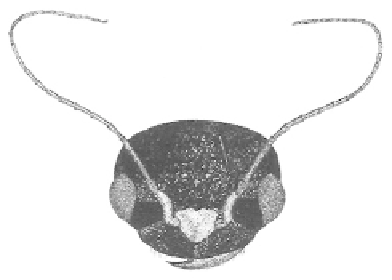Agriculture Reference
In-Depth Information
in diameter, hemispherical and strongly
ribbed; pale yellow, with darker mark-
ings.
Larva
up to 40 mm long;
body
plump, yel-
lowish-green or brownish, with a thin, broken
line, and feint V-shaped or W-shaped marks
along the back;
spiracles
white and black-
rimmed.
BIOLOGY
Eggs are laid in groups and then covered with
hairs from the adult moth. The eggs hatch within
a few days at normal glasshouse temperatures.
The larvae feed mainly at night and, when fully
grown, pupate in the soil a few centimetres
below the surface. The development and survival
of this multivoltine species depends considerably
on temperature; breeding is continuous whilst
conditions remain favourable.
Spodoptera littoralis
(Boisduval)
Mediterranean brocade moth
DESCRIPTION
Adult
35-40 mm wingspan;
forewings
reddish-
brown, with pale markings (some of which high-
light the veins) and partly suffused with grey
(fresh specimens have a purplish sheen)
(Plate
15f);
hindwings
mainly whitish.
Larva
up to
45 mm long;
body
extremely variable in colour
(ranging from green to dark brown), often no-
ticeably speckled with white and with paired
velvet-black patches on at least the first and
eighth abdominal segments.
This tropical and subtropical pest is established
in various parts of southern Europe where it
attacks a range of crops, including glasshouse-
grown ornamentals and vegetable crops. The lar-
vae (often known as 'Mediterranean climbing
cutworms') cause extensive defoliation; they also
damage stems and flowers. In the British Isles,
larvae are found occasionally on imported
plants, especially chrysanthemum; the adult is a
very rare 'natural' immigrant.
ORDER HYMENOPTERA (ANTS, BEES,
SAWFLIES, WASPS, ETC.)
Family PAMPHILIDAE
Neurotoma saltuum
L.
Social pear sawfly
eventually pupate in the spring, each in a flimsy
silken cocoon.
DESCRIPTION
Adult
ll-14mm long;
head
black with a distinc-
tive yellow patch between the antennae
(Fig.
328);
thorax
black, with yellow tegulae;
abdomen
Infestations of this local, southerly distributed
and sporadic pest occur on pear and, occasion-
ally, other rosaceous hosts (Rosaceae) such as
cherry and plum. The larvae feed gregariously in
conspicuous webs, and often completely strip the
foliage from affected shoots and branches. At-
tacks occur most frequently on young trees.
BIOLOGY
The active, fast-flying adults occur in May and
June. Eggs are laid in large batches of about 50
on the underside of leaves and are then covered
in a sticky, protective secretion. Larvae occur
mainly in June and July. They feed voraciously,
and their silken tents soon become very obvious.
Fully fed individuals overwinter in the soil and
Fig. 328
Head of social pear sawfly,
Neurotoma
saltuum.

